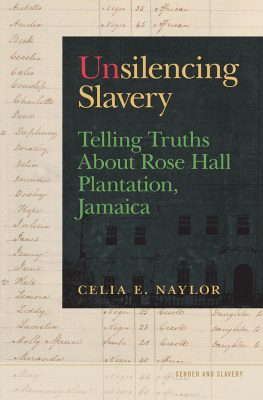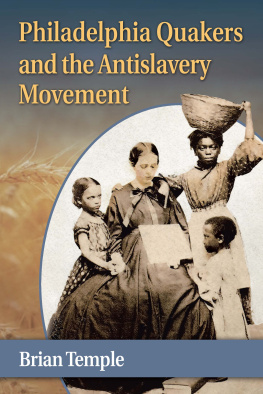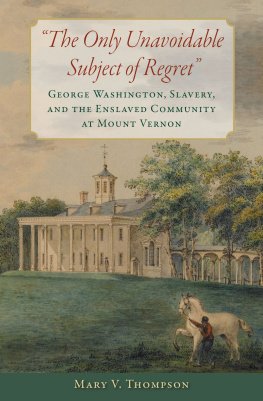Many people helped me in this project in many ways, and in some cases I regret that I do not know their names, so I can only thank them indirectly. I want to especially mention Michael Coard and the members of Avenging the Ancestors Coalition (ATAC) for both the help and friendship they offered. I also want to thank the many people who spent time with me explaining their perspective on the Presidents House/Slavery Memorial conflict and the other conflicts I write about here: including Clay Armbrister, Terry Buckalew, Joe Certaine, Peter DiCarlo, John Dowell, Lauren Dougherty, Doris Fanelli, Michelle Flamer, Lisa Hopkins, Germaine Ingram, Emanuel Kelly, Emma Lapsansky-Werner, Ed Lawler, Donald Leland, Jed Levin, Ron McCoy, Joseph McGill, Roz McPherson, Randall Miller, Cynthia MacLeod, Louis Massiah, Joe Nicholson, Richard Rabinowitz, Sacaree Rhodes, Stephan Salisbury, Karen Warrington, and David Young. Among those people who read some or all of the manuscript at various stages, I wish to thank are David Karen, Michael Rock, Randall Miller, and Mark Wolfgram provided detailed comments on the entire manuscript. In addition, Ed Linenthal, Bob Washington, Sharon Ullman, Michael Zuckerman, David Waldstreicher, Joanne Melish, and Terry Buckalew provided helpful ideas after reading some or all of the manuscript. I owe special thanks to Pamela Haag for particularly careful and thoughtful editing as well as myriad useful suggestions. At the University of Pennsylvania Press, I want to especially thank editor-in-chief Peter Agree for his strong support and many thoughtful ideas and suggestions that significantly improved the organization and arguments I offer here, from the time he first heard about this project through its completion. As always, Noreen OConnor-Abel did a superb job in guiding the book through the production stage, offering many carefully considered, thoughtful, and detailed editorial suggestions.
I also want to add a special shout-out to Natalie Mankoff, our charming granddaughter, who asked me a lot of questions about the book a few months before she turned seven. When I told her, I had a completed first draft and was going to edit and rewrite many things in the next round, she solemnly explained to me, You know, Gramps, I know that editing and rewriting anything several times always makes it better. How sweet and how true coming from a person of any age.
Last, as always, I want to thank the love of my life, Katherine Conner, who not only read early drafts of the chapters, but also patiently heard me go on endlessly about what I was reading and thinking about as this project progressed. She also accompanied me on every road trip we took for this research and shared her thoughts and reactions to each site we visited helping me articulate my own ideas much more clearly than I would have otherwise. I am very lucky.
All history is retrospective. Were always looking at the past through the lens of later developments. How else could we see it? We see ourselves, as subjects, among those later developments.
Louis Menand, The Elvic Oracle, New Yorker, November 16, 2015
It is tempting to think about collective memories simply as the sum of individual memories, but the two types are stored quite differently and have very different life histories. Individual memories are idiosyncratic. They are socially rooted but are stored in individual brains through neurological processes that are still somewhat mysterious, though they have become better understood in recent years. When individuals die, their memories are lost forever unless these have been recorded or passed on to others. However, collective memories are stored entirely differently, and individuals and groups often access them for hundreds of years or more. They exist in narratives that are recounted to the young and old alike, in images created by artists, photographs, films and television shows, books, musical compositions, statues, monuments, memorials, museums, buildings, ritual events, former battlefields, and other sacred sites. In some cases, the memories stored are explicit in their messages, while others are more metaphorical and require interpretations that can, and do, shift over time. The messages found in these cultural expressions are not necessarily enduring, however, and they require active contemporary engagement, interpretation, and accessibility to remain emotionally meaningful, even when they are initially set in stone and intended to be eternal. Places associated with people and events both sacred and mundane are another crucial device for the preservation of collective memories (Connerton 1989; Nora 1989; Ross 2009a).
Historian Alon Confino defines collective memory as a subjective experience of a social group that essentially sustains a relationship of power. Simply stated, it is who wants whom to remember what and why (1997: 1393). Confino also points out that, One of the significant contributions of memory studies has been to explore how the construction of the past, through a process of invention and appropriation, affected the relationship of power within society (1997: 1393). Collective memories are about emotionally salient events and persons in the past that have particular relevance to how a group understands itself and the challenges it faces in the present and future. These accounts are not simply trivial historical details about the past. They convey crucial social, political, and moral lessons that can be important resources in present struggles. This means that collective memories are, as Trouillot argues always incomplete (Trouillot 1995: 4952). Blight makes a similar point when he says, Collective memory should be seen as a set of practices and ideas embedded in a culture, which people learn to decode and convert into their identities (2002).
Some authors interested in this topic focus on the difference between popular memory and history, the latter of which emphasizes facts, specific events, and truths (as positivists use the term), and an objective past that can be found in documents and other artifacts such as archaeological evidence. People generally understand the past by situating it within their social framework and developing a more subjective understanding of it through popular narratives and accounts. They experience it through the eyes and minds of participants in the events and their descendants (Rosenzweig and Thelen 1998; Olick, Vinitzky-Seroussi, and Levy 2011). For others, however, the distinction is not so clear once they explore the constructed and selective use of historical facts. Trouillot (1995: 38) questions the utility of the extreme positions of both the positivist and constructivist models, arguing: Whereas the positivist view hides the tropes of power behind a nave epistemology, the constructivist one denies the autonomy of the sociohistorical process. Taken to its logical end point, constructivism views the historical narrative as one fiction among others (Trouillot 1995: 6).
Recent interest in collective memory extends back to Maurice Halbwachs and the Annales School in France in the mid- to late twentieth century. Their work focused on social history and memories and mentalities outside the purview of the official state histories of formal institutions, wars, and kings. These historians saw it as crucial to understand the system of beliefs and collective representations, myths, and images with which people in the past understood and gave meaning to their world (Confino 2011: 37). Young (1993: 6), citing Halbwachs, also argues that both the reasons for memory and the forms memory takes are always socially mandated.
An oversimplified distinction between objective history and subjective popular memory also fails to recognize that both are built on particular narratives. These narratives include plausible explanations about the past, as found in culturally accessible locations such as archives, school texts, films, commemorative events, family stories, and emotionally significant sacred places, which are also the foundations for public history. For Confino, the distinction between history and memory is complicated because history, like memory, is socially and culturally constituted, even though Historians create narratives about the past with the





